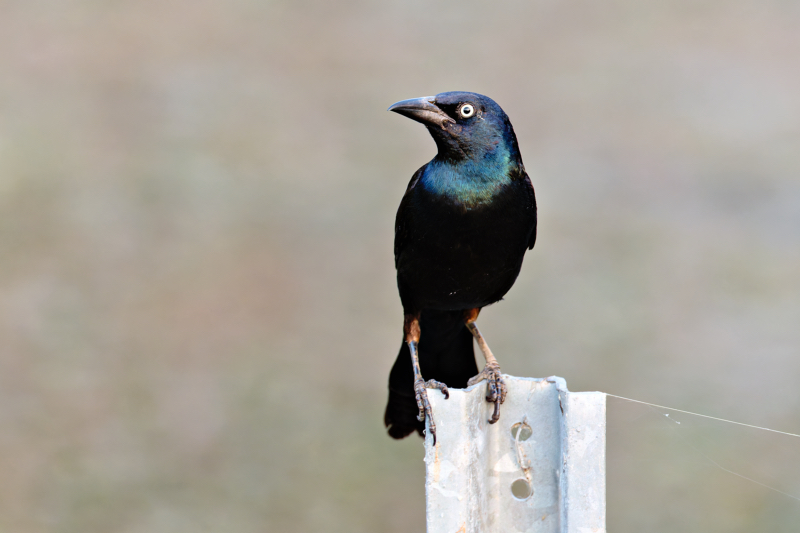In June 2018, I photographed a Common Grackle at Sequoyah National Wildlife Refuge in Oklahoma, which is a site known for its diverse bird population and excellent photography opportunities. Moreover, the refuge’s unique habitats make it a haven for wildlife enthusiasts. The bird perched on a metal rail sticking out of the water in the Miner’s Cove area, which offered a perfect moment for a close-up. Additionally, the calm surroundings made it easier to focus on the shot. I parked along the tour road, using my vehicle as a blind to avoid startling the bird.

Camera Settings and Setup
To capture the image, I used a Canon EOS 7D Mark II with a Canon EF 100-400mm f/4.5-5.6L IS II lens. The camera rested on a bean bag draped over my pickup’s open window for stability. Here were the settings:
- Shooting Mode: Aperture Priority (AV)
- Shutter Speed: 1/200 sec
- Aperture: f/5.6
- ISO: 1000
The f/5.6 aperture created a shallow depth of field, which blurred the background and emphasized the grackle’s iridescent feathers. Furthermore, this defining feature highlights their unique and striking appearance. Although the shutter speed of 1/200 sec captured the bird’s stillness, a faster setting would have been preferable for sudden movement. The ISO 1000 ensured proper exposure under the available light.
About the Common Grackle
Common Grackles are large blackbirds with iridescent feathers that shift between blue, purple, and green depending on the light. This iridescence, caused by microscopic feather structures that refract and scatter light, makes them visually captivating. Their bright yellow eyes further enhance their striking appearance.
These adaptable birds have a varied diet that includes insects, seeds, fruit, and small aquatic animals. At Sequoyah National Wildlife Refuge, they’re frequently seen near water, either feeding or bathing.
In summer, grackles form loose colonies and gather in groups near wetlands or fields. Consequently, this behavior makes them easier to spot during this season. They thrive in both rural and urban environments. Their vocalizations—a mix of harsh calls and whistles—add to the natural soundscape of the refuge.
Tips for Photographing Common Grackles
- Highlight Iridescence: Use natural light to bring out their shimmering feathers.
- Use a Telephoto Lens: Capture detailed shots without disturbing the bird.
- Increase Shutter Speed: For active birds, set the shutter speed to 1/500 sec or higher to freeze motion.
- Shoot from Eye Level: A low angle creates a more intimate composition.
Sequoyah National Wildlife Refuge: A Birdwatcher’s Spot
The Sequoyah National Wildlife Refuge provides diverse habitats for numerous bird species, including the Common Grackle. Its wetlands and wooded areas offer ample food and nesting sites. Miner’s Cove, where this photo was taken, is especially good for observing bird behaviors. Other birds commonly spotted in this area include Great Blue Herons, Belted Kingfishers, and Red-winged Blackbirds.
Photographing this grackle reminded me of the beauty found in common species. For additional information about grackles and other bird species, visit the Cornell Lab of Ornithology’s Bird Guide. As a result, I often find myself appreciating these everyday moments in nature even more. This experience reinforced my approach to wildlife photography, focusing on the remarkable traits of all animals, not just rare or exotic ones. Their shimmering feathers and bold gaze make them striking subjects. This moment highlighted the importance of appreciating all aspects of nature, from rare sightings to everyday encounters.
